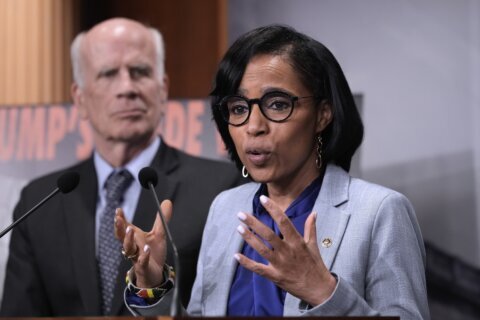This article was republished with permission from WTOP’s news partners at Maryland Matters. Sign up for Maryland Matters’ free email subscription today.
This article was written by WTOP’s news partners at Maryland Matters and republished with permission. Sign up for Maryland Matters’ free email subscription today.
William H. Cole IV recalls the 2020 Preakness Stakes at Pimlico Race Course as “definitely surreal.”
Because of COVID-19 restrictions, the crowd was limited to around 250, which only included horse owners, trainers and their guests. Two years ago, Preakness Day attracted 130,000 fans.
Instead of being held in mid-May, last year’s race was postponed until October, after the Belmont Stakes and Kentucky Derby.
“It was really weird to be able to hear the horses as they’re coming down the back stretch toward the finish line,” said Cole, former CEO of the Baltimore Development Corporation. “Usually when there are that many people, you don’t actually hear the hoofs hitting the dirt.”
But Cole, who was lead negotiator in the historic deal to revitalize Pimlico and its surrounding neighborhoods, says there is finally reason for optimism that the Preakness will remain in Baltimore.
The multi-year development plan calls for $375 million in funding, primarily through the sale of state bonds, over 30 years. The Stronach Group, which owns Pimlico and Laurel Park, has agreed to transfer ownership of the track to the City of Baltimore. The aging track will eventually be demolished and replaced with a state-of-the-art facility.
Cole says the project “will also connect the track to surrounding neighborhoods, to make certain that it becomes a community amenity and not just the home of the Preakness Stakes.”
Plans call for rotating the existing track by 30-degrees, which Cole says will “create a lot of opportunity for private development to surround the track.”
Once that happens, “I can see restaurants, a grocery store and other retail with access to a new park with new athletic fields and a facility that is attractive to the Greater Baltimore community,” Cole said.
Just over two years ago, the massive plan to revitalize Pimlico and surrounding neighborhoods appeared virtually impossible. The Stronach Group was often criticized for allowing the facility to deteriorate without making any major renovations. In early 2019, Baltimore Mayor Catherine Pugh became so worried the Preakness would be moved out of state, she authorized the City of Baltimore to file suit against the Stronach Group, in efforts to seize control of the property through eminent domain.
When Pugh was forced to resign amid political corruption charges, Bernard C. “Jack” Young, her successor, met face-to-face with company president Belinda Stronach in efforts to resolve the legal battle. One month later, the city agreed to drop its lawsuit against the Stronach Group, and negotiations began on a long-term deal to keep the Preakness in Baltimore.
“Give Jack (Young) a ton of credit for approaching Belinda Stronach directly at the Preakness and asking her what we could do to reset this conversation, and that small gesture led to a very, very productive relationship moving forward,” Cole said.
Del. Samuel I. Rosenberg is a Democrat who has represented Northwest Baltimore for more than 35 years.
“The Preakness is the Second Jewel of the Triple Crown. This will be a jewel of a redevelopment if we do it right, and I have every reason to believe that we will,” Rosenberg said. “In addition to the construction jobs it will provide, it is an important investment that will not stay within the confines of that site.”
The Maryland Stadium Authority, which coordinated construction of Oriole Park at Camden Yards 30 years ago, will oversee the massive renovation project at Pimlico.
Gary McGuigan, executive vice president of the Stadium Authority, says the agency has hired two architectural firms to oversee the design work, which is expected to take up to two years. The entire project could take several more years to be completed.
“To make a complex endeavor even more complex, the city wants the Preakness to stay (at Pimlico) during construction, so we have to figure that part out with opening back up while under construction,” McGuigan said.
The revitalization plan also calls for major improvements at Laurel Park, where the vast majority of live racing days will continue.
Yeshiyah B. Israel, president of the Pimlico Merchants Association, says she is anxiously waiting to see how the redevelopment project takes shape.
“We know that jobs are important, and with jobs comes beautification and more homeowners, and it just makes the community more vibrant and more positive,” she said.
Ameen Ansar, whose family owns Halal Food on Park Heights Avenue, is encouraged with news of the revitalization plan for the community. But he says it will only succeed if the city can address what he calls the relentless crime problem.
“People enjoy going to the Preakness, but every time you turn your TV on, someone’s getting shot. The city is just falling apart,” said Ansar, who has lived in the Park Heights community for many years.
Attendance at the 146th running of the Preakness will be limited to just 10,000 due to COVID-19 restrictions.
“Hopefully they’ll be able to add a significant number of fans next year, well above what we had last October,” said Cole, who plans to attend Saturday’s race. “…And hopefully by next Preakness, it’ll be back to normal.”
John Rydell has covered state politics for more than 30 years with WBFF-TV and Maryland Public Television. He can be reached at jprydell@verizon.net.







